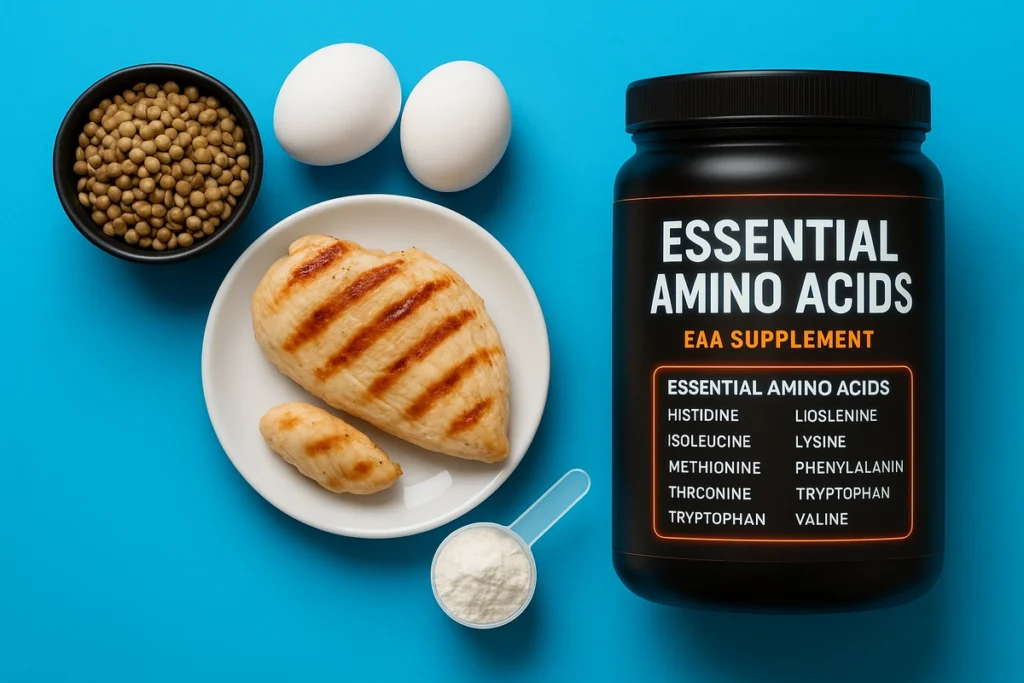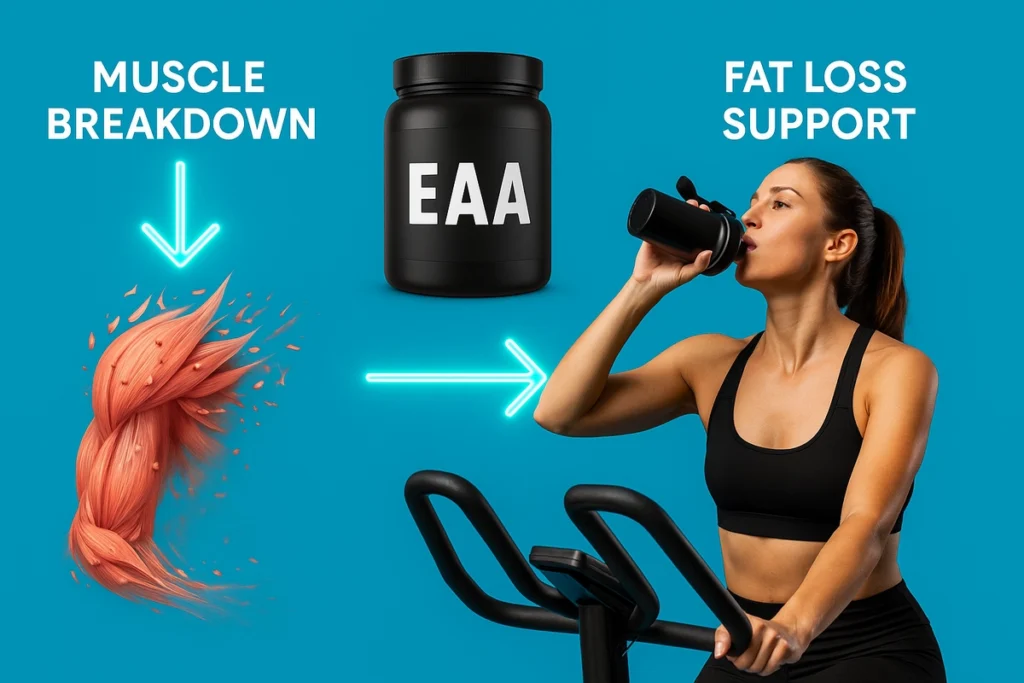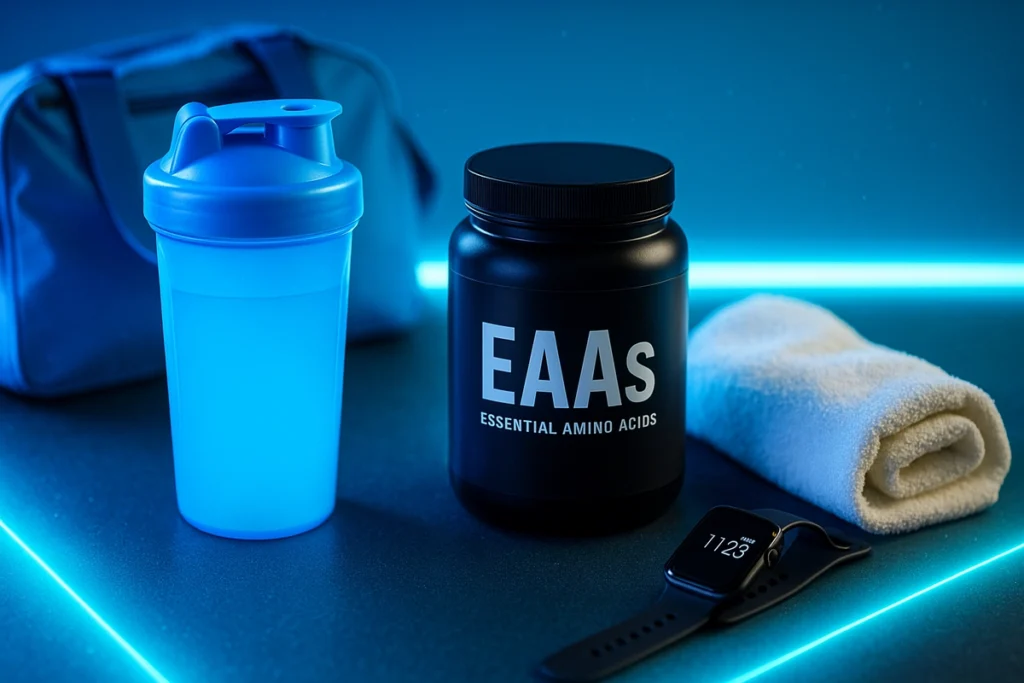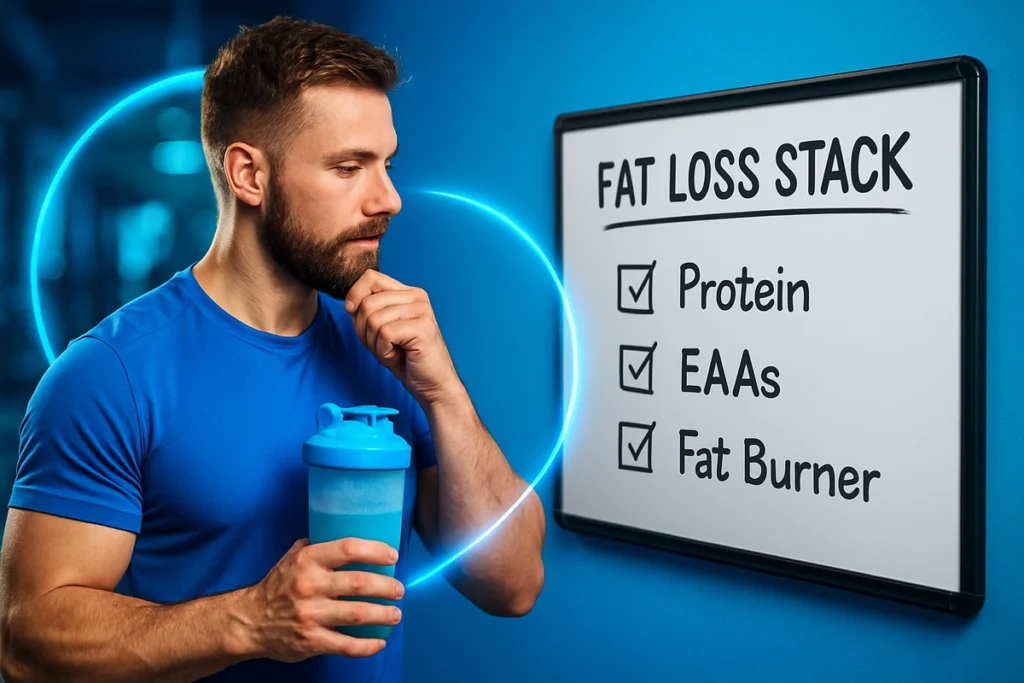Want to burn fat without sacrificing your hard-earned muscle?
If you’ve ever dieted hard only to end up looking flat, weak, or “skinny-fat,” you’re not alone — and I’ve been there too.
Here’s some good news: Essential Amino Acids (EAAs) might be the missing link in your fat loss phase.
In this article, I’ll break down how EAAs help preserve muscle and support fat loss, based on science, real coaching experience, and personal results.
Table of contents
- Quick Answer
- What Are EAAs and Why Do They Matter?
- How EAAs Support Muscle Retention During Calorie Deficits
- Can EAAs Boost Fat Loss Directly? What Science Says
- When to Take EAAs for Best Results
- Real Results: What I’ve Seen with Clients (Trainer’s Insight)
- Who Should Use EAAs During Cutting Phases?
- Final Verdict: Should You Add EAAs to Your Fat Loss Stack?
- Final Tip from Coach Hossein:
Quick Answer

Yes — EAAs absolutely help preserve muscle during fat loss.
They don’t directly burn fat like caffeine or fat burners, but they play a huge role in keeping your muscle tissue intact during calorie deficits. And trust me, that’s a game-changer.
I’ve used them in my own cuts and recommended them to dozens of clients. Results?
More energy, less muscle loss, better training performance — and leaner, more defined results.
What Are EAAs and Why Do They Matter?

EAAs are the 9 essential amino acids your body can’t produce on its own.
You either get them from high-protein foods or smart supplementation.
Unlike BCAAs (which only contain 3 aminos), EAAs provide everything your muscles need to grow, repair, and stay protected — especially when you’re cutting.
Think of them as the raw materials for muscle preservation, without the calories of a full meal or protein shake.
If you want to go deeper on this, check out my article: EAAs vs Protein Powder: Which One Works Best?
How EAAs Support Muscle Retention During Calorie Deficits

When you’re in a calorie deficit, your body doesn’t just burn fat — it starts pulling from muscle tissue, too. That’s bad news for your strength, shape, and metabolism.
This is where EAAs shine.
They feed your muscles exactly what they need to maintain size and strength, even when you’re eating less.
I’ve used EAAs personally during tough cuts and the difference was huge:
- Less soreness
- Better recovery
- And no “flat” look that usually comes with depleted carbs.
One client, James from the UK, added EAAs to his fasted morning routine while prepping for a photoshoot. He dropped body fat while holding onto his muscle tone — and actually gained confidence seeing his pump stay solid throughout the cut.
To learn more about EAA use during weight loss phases in women, check this: EAAs for Women in Strength Training
Can EAAs Boost Fat Loss Directly? What Science Says

Let’s be clear: EAAs aren’t fat burners.
But they do something just as important. They protect your lean muscle, which keeps your metabolism high.
The more muscle you retain, the more calories you burn at rest — and the easier it becomes to create a fat-burning environment. That’s how EAAs support fat loss indirectly.
One of my clients, Daniel from Canada, went through a 6-week aggressive cut. We kept his calories tight, but used EAAs during every early workout. He lost 5+ kg — but more importantly, kept his muscle fullness and strength. No metabolic slowdown. No crash.
When to Take EAAs for Best Results

Timing matters. Here’s what I’ve found works best:
- Before fasted cardio or lifting
- Intra-workout during resistance training
- Between meals on low-protein days
These are the windows when your body’s most catabolic — and when EAAs make the biggest impact.
They’re light on the stomach and fast-absorbing, which is great when you’re already feeling depleted.
In my own routine, sipping EAAs during longer sessions helps me stay focused, energized, and strong, even in a deficit.
You can dive deeper into timing here: Best Time to Take EAAs
Also check: EAAs During Workout Guide
Real Results: What I’ve Seen with Clients (Trainer’s Insight)

I’ve coached dozens of lifters — men and women — through cutting phases.
Here’s what I’ve noticed with those who use EAAs vs those who don’t:
🟢 With EAAs:
- Muscle tone stays fuller
- Strength holds up better
- Recovery is faster
- Mood and energy improve
🔴 Without EAAs:
- Strength drops faster
- Muscle looks flatter
- Recovery suffers, especially during fasted training
A perfect comparison was between Ryan and Leila, both in a 3-week mini cut.
Same plan, same workouts.
Ryan used EAAs around training — Leila didn’t.
By week three, Ryan was holding all his lifts and looking tighter. Leila? Weaker lifts and visible size drop.
Want to know how EAAs stack up against BCAAs? Read this: EAAs vs BCAAs: Which One Wins During Workouts?
Who Should Use EAAs During Cutting Phases?

EAAs aren’t for everyone — but they’re a great tool for:
- Lifters doing fasted cardio or weight training
- People with lower daily protein intake
- Those in deep calorie deficits or competition preps
- Anyone trying to retain lean muscle while leaning out
If you’re pushing your body hard while restricting food, EAAs help bridge the gap without sabotaging your fat loss.
Final Verdict: Should You Add EAAs to Your Fat Loss Stack?

If you’re serious about burning fat and keeping muscle, EAAs are worth every sip.
They’re not a magic solution, but they’re a smart, effective tool — especially if you train hard and diet smart.
That said, if you’re barely hitting your protein goals, focus on whole foods or whey protein first.
But if you’ve already nailed the basics and want to take your results further — EAAs are a powerful edge.
I always remind my clients: Use EAAs strategically — not randomly. Don’t expect overnight fat loss. Expect muscle protection that pays off over time.
Final Tip from Coach Hossein:
If you’re only using one supplement during your cut, make sure it supports your actual goal — which is not just fat loss, but fat loss with a strong, athletic physique.
EAAs help you train like a lifter, not just diet like one.
And in my book, that’s a win.



Leave a Reply